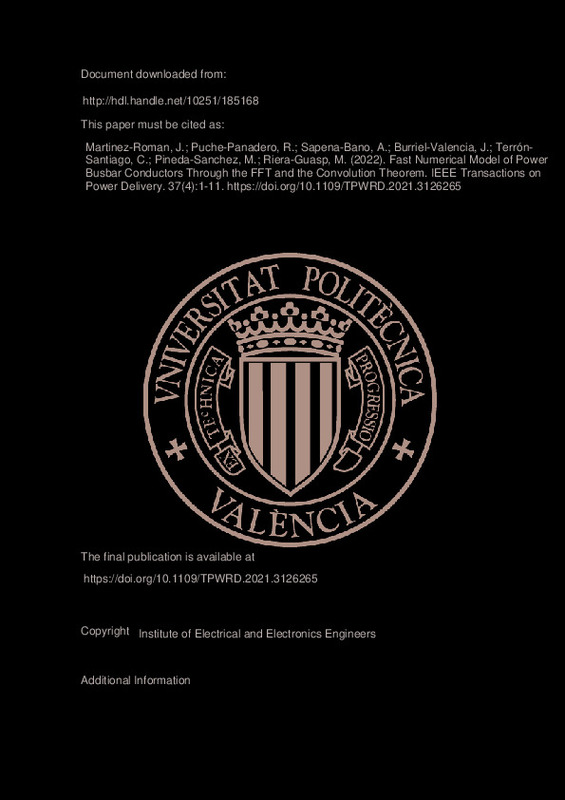Martinez-Roman, J.; Puche-Panadero, R.; Sapena-Bano, A.; Burriel-Valencia, J.; Terrón-Santiago, C.; Pineda-Sanchez, M.; Riera-Guasp, M. (2022). Fast Numerical Model of Power Busbar Conductors Through the FFT and the Convolution Theorem. IEEE Transactions on Power Delivery. 37(4):1-11. https://doi.org/10.1109/TPWRD.2021.3126265
Por favor, use este identificador para citar o enlazar este ítem: http://hdl.handle.net/10251/185168
|
Título:
|
Fast Numerical Model of Power Busbar Conductors Through the FFT and the Convolution Theorem
|
|
Autor:
|

 Martinez-Roman, Javier
Martinez-Roman, Javier

 Puche-Panadero, Rubén
Puche-Panadero, Rubén

 Sapena-Bano, Angel
Sapena-Bano, Angel

 Burriel-Valencia, Jordi
Burriel-Valencia, Jordi

 Terrón-Santiago, Carla
Terrón-Santiago, Carla

 Pineda-Sanchez, Manuel
Pineda-Sanchez, Manuel

 Riera-Guasp, Martín
Riera-Guasp, Martín
|
|
Entidad UPV:
|
Universitat Politècnica de València. Departamento de Ingeniería Eléctrica - Departament d'Enginyeria Elèctrica
|
|
Fecha difusión:
|
|
|
Resumen:
|
[EN] Skin and proximity effects can cause a non-uniform
current distribution in the electrical conductors used in alternating current (ac) busbar systems, which increases resistance,
decreases internal inductance, and ...[+]
[EN] Skin and proximity effects can cause a non-uniform
current distribution in the electrical conductors used in alternating current (ac) busbar systems, which increases resistance,
decreases internal inductance, and causes asymmetries in the
electromagnetic fields and forces. As no explicit solution for the
ac resistance or the ac internal inductance of a rectangular
conductor has been found, numerical methods are needed to
obtain the distribution of the currents inside the busbars. In this
paper, a novel numerical approach, based on the fast Fourier
transform (FFT) and the convolution theorem, is proposed to
model the rectangular conductors of the busbar system, based
on the subdivision of the conductor in filamentary subconductors.
This technique is know to lead to a dense, huge inductance
matrix, that must be multiplied by the current vector, which
limits its practical application. The proposed method replaces this
matrix-vector multiplication with a simple element-wise vector
product in the spatial frequency domain. The FFT speed makes
the proposed method very fast and easy to apply. This approach
is theoretically explained and applied to an industrial busbar
system.
[-]
|
|
Palabras clave:
|
Current density
,
Inductance
,
Skin effect
,
Spectral analysis
,
Convolution
|
|
Derechos de uso:
|
Reserva de todos los derechos
|
|
Fuente:
|
IEEE Transactions on Power Delivery. (issn:
0885-8977
)
|
|
DOI:
|
10.1109/TPWRD.2021.3126265
|
|
Editorial:
|
Institute of Electrical and Electronics Engineers
|
|
Versión del editor:
|
https://doi.org/10.1109/TPWRD.2021.3126265
|
|
Coste APC:
|
544,5 €
|
|
Código del Proyecto:
|
info:eu-repo/grantAgreement/AEI/Plan Estatal de Investigación Científica y Técnica y de Innovación 2017-2020/RTI2018-102175-B-I00/ES/DISEÑO DE MODELOS AVANZADOS DE SIMULACION DE AEROGENERADORES PARA EL DESARROLLO Y PUESTA A PUNTO DE SISTEMAS DE DIAGNOSTICO DE AVERIAS "ON-LINE"/
|
|
Agradecimientos:
|
This work was supported in part by the Spanish Ministerio de
Ciencia, Innovación y Universidades (MCIU), in part by the Agencia Estatal de
Investigación (AEI), and in part by the Fondo Europeo de Desarrollo Regional
(FEDER) ...[+]
This work was supported in part by the Spanish Ministerio de
Ciencia, Innovación y Universidades (MCIU), in part by the Agencia Estatal de
Investigación (AEI), and in part by the Fondo Europeo de Desarrollo Regional
(FEDER) in the framework of the Proyectos I+D+i - Retos Investigación 2018,
under Project Reference RTI2018-102175-B-I00 (MCIU/AEI/FEDER, UE).
[-]
|
|
Tipo:
|
Artículo
|







![[Cerrado]](/themes/UPV/images/candado.png)


